Design resilience – Building for longevity & the route to net zero
Assael’s Design Resilience Campaign is centered around the concept of ‘resilience’, meaning the adaptability of the built environment and its responsiveness to change.
Through Q&A-style interviews, we’ll explore resilience from several dimensions, each interview arranged around several core themes, such as climate, ecology, human and community resilience.
In this first instalment of Assael’s Design Resilience Campaign, Assael’s Rory O’Hagan talks resilience, longevity, reuse and the route to net zero with Meridian Water’s Sustainability Facilitator Rafe Bertram and Sustainability Director at AECOM David Cheshire.
Download the RightSizer report here.

Meridian Water is one of the UK’s largest regeneration programmes, providing 10,000 homes and 6,000 jobs in Enfield, north London, over 25 years. In its second phase of development, master developers Enfield Council sought ideas from designers to embed the “triple bottom-line” fundamentals of social, environmental and economic sustainability into Meridian Water, selecting Assael Architecture’s RightSizer as the winning submission in its “Placemaking with Purpose” design competition in 2020.
RightSizer is Assael’s vision for a flexible and sustainable universal construction system that allows for Design for Manufacture, Assembly and Disassembly (DfMAD), creating buildings where people can age in place. With support from AECOM, Exterior Architecture, ArchitectureDoingPlace and Hatch Urban Solutions, amongst others, the circular economy principles of this design approach embody industry resilience and building longevity and provide a ‘how-to’ guide to building for 2030 and beyond, permitting reconfiguration and the recycling of modular components for constant reinvention of the built environment.
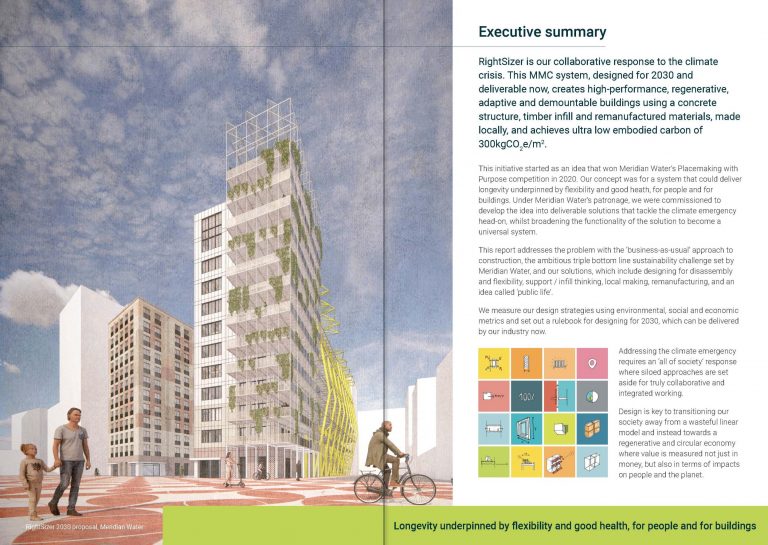
Could you explain your respective roles, and the key design principles that have informed the masterplanning and delivery of RightSizer at Meridian Water?
Rafe: For anybody who isn’t aware, Meridian Water is a strategic brownfield site in north-east London, south of the North Circular and west of Lee Valley Regional Park, and is a major 25-year programme of regeneration. Enfield Council has taken the opportunity to be the master developer of the project, providing a mixture of homes and tenures, including London living rent, social and affordable, in addition to 6,000 high-quality jobs and new public spaces for the new and existing community.
As Sustainability Lead for the project, my role is to put Enfield’s vision into practice in a way that ensures Meridian Water is a standard-bearer for sustainable living. The project teams that we’re working with day-to-day are all committed to building a carbon neutral community, by building energy-efficient homes, reducing dependence on non-renewable resources, plugging into sustainable transport networks, and improving air quality and biodiversity for the benefit of public health.
David: AECOM’s involvement in RightSizer at Meridian Water has been right from the start, originally through an ideas competition that invited multi-disciplinary teams, including structural and services engineers, cost consultants, as well as sustainability experts, to develop circular economy principles which could be applied to the project. The workshops with Enfield Council and Assael have been challenging in a cool way; they’re ambitious, and really experimental, discussing topics like recirculating water, reclaiming re-usable materials, designing for disassembly, adaptable and demountable buildings, intergenerationality, and how buildings can be repurposed over time.
RightSizer, Assael’s inspired design strategy for Meridian Water, is an embodiment of these principles. As a team, we searched for ways to make the project more sustainable, radically reducing embodied carbon emissions, using reclaimed materials, and targeting 40% regenerative components at the outset. It was important to have cost consultants involved from the beginning to understand what’s feasible, how the use of reclaimed components from ‘donor buildings’ can suppress costs, and to rationalise to avoid generating huge amounts of waste in construction and through the life of the project.
What Rafe said is interesting: rather than saying that targets are too challenging, we have to accept the targets and figure out a way to achieve them, because there is no choice when it comes to a crisis in climate. We have to be sustainable now to safeguard the future.
Rory: We worked on RightSizer through the depths of lockdown, researching the circular economy, its drivers and organising principles, drawing out how these could be applied to Meridian Water. It has been a privilege to work on something so inspiring and freewheeling during the darkest days of the pandemic. We were fortunate to have a client with a big vision, exciting brief and the resources to allow us to think and innovate to address the climate emergency and fundamentally challenge the construction status quo.
RightSizer was our submission to Enfield’s Placemaking with Purpose competition, which was essentially a testing exercise that sought ways to create buildings that meet Meridian Water’s triple bottom-line approach (environmental, social and economic sustainability). At the time, we were looking for ways to incorporate these three pillars into a universal build system and had been exploring intergenerational communities in the context of senior living, which could be weaved sustainably into urban centres. That really emphasised the need for adaptability – in terms of physical and care needs that are dynamic in a cohort of seniors, but also in the way buildings could be adapted and repurposed to drive longevity.
RightSizer is our strategy to reduce embodied carbon through the use of mixed materials, including concrete, providing enhanced building adaptability and a built-in capacity for different future uses, which could be applied to an array of different use cases across Meridian Water.
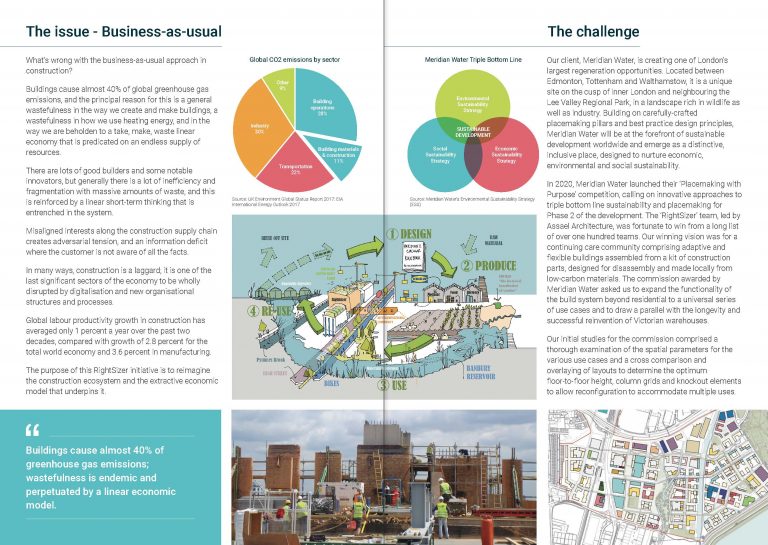
Sustainability and building for flexibility lie at the core of the way we’re thinking about the future of the built environment. Is this approach new, and if not, how does it differ from other masterplans?
Rafe: The approach we’ve taken to Meridian Water is actually not new, or different – adaptive buildings have been around for centuries. What this is, is a revival of a historically more commonplace approach.
Meridian Water’s masterplan is designed to be replicable, appropriate, and of its place, and made with the people who will inhabit it. Nothing is intended to be invention for the sake of it, because in sustainability terms, we want to do better than brand new approaches for the sake of it. We now have scientific evidence to show what new environments need to do to reduce pressures mounting on the planet, and how they can meet these needs via non-governmental bodies ranging from RIBA, UKGBC, right up to the Intergovernmental Panel on Climate Change (IPCC).
The only change is that you have to really believe it and action against real, genuine targets. We need to really believe that we can solve the challenges ahead of us and be prepared to perform to those expectations together with partners, cost consultants, developers, financiers, commercial teams, and everybody within the Council. We know what’s coming if we fail to listen to the alarm bells ringing.
Given the body of scientific research we now have, it’s crazy to be demolishing existing buildings unnecessarily. We should be adapting buildings wherever we can, at many levels, being resilient and allowing buildings to evolve to suit life situations which change all the time. Growing old, falling in love, and raising a family shouldn’t mean we need to relocate to a new community at each stage of our lives.
So how do we make places that are truly capable of sustaining multiple generations? RightSizer is the strategy to translate these ideas into construction. By replicating circular economy principles that apply environmentally to the community that inhabits Meridian Water, we can plan for future generations by dismantling and recycling, even using modular building elements for meanwhile uses as well as permanent homes.
Construction needs to be more adaptable than we’re used to.
David: I entirely agree with Rafe, but there’s two really important things that have to happen here to enable genuine sustainability across the construction process.
First, sustainability targets need to be in the brief. Often, net zero is an afterthought despite the urgency and immediacy of climate change. The design process, and construction, is driven by the brief; we shouldn’t be prepared to back down, and these should be the outcomes, not sidelined milestones.
This is what’s ‘new’ about Meridian Water in a sense: they have said “these are the figures we want to hit” and those figures are non-negotiable.
Second, buildings must be future-proofed. This means adaptability, not merely flexibility. To me, flexibility is within the same use type, while adaptability is to achieve fluidity, transitioning from residential to lots of different uses.
When Victorian warehouses were designed, their architects couldn’t have anticipated that these would be converted to trendy apartments in the future. But there was a lot of thought about the factors that matter: open and generous spaces, well-proportioned glazing ratios that let in light but do not allow too much solar gain, keeping the floorplates simple. There are lots of lessons to be learned from the buildings that have lasted over a hundred years and are cherished by the community.
Even then, when we design for adaptability, we might still get it wrong in form or shape. After all, we can only speculate what future requirements of the built environment will look like. Therefore, we must also design for disassembly. Future generations must be given the gifts of a building with components and materials that can be salvaged and reused elsewhere. Victorians laid their bricks on limestone, and so we can take them apart and salvage them; we need to find new ways to do this to allow our building to become materials banks for future generations.
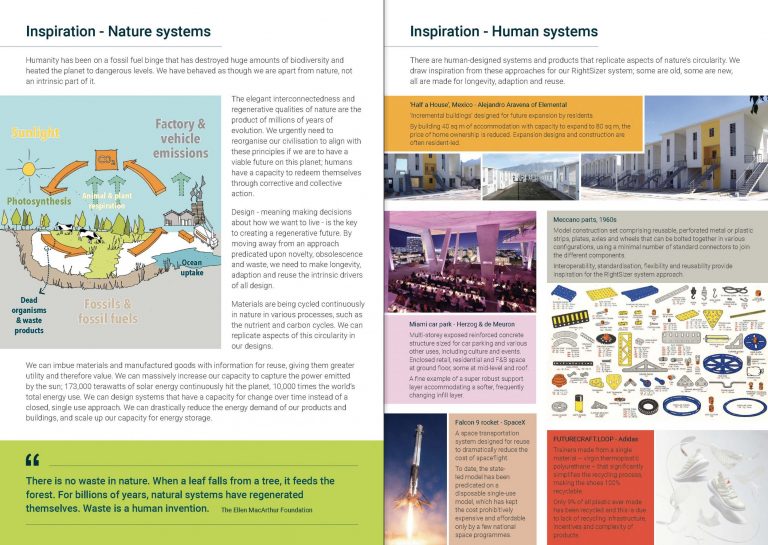
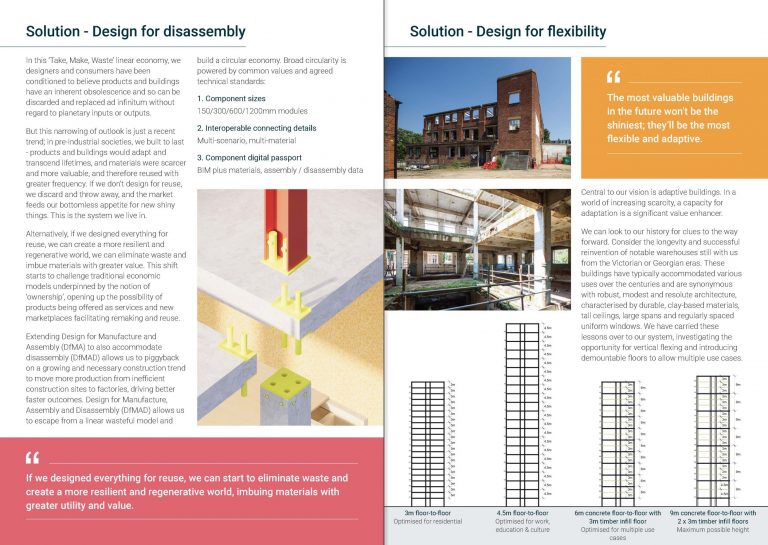
Modular construction and the principles of DfMA (designing for manufacture and assembly) is central to the RightSizer approach. How does this selection enable Meridian Water to be more resilient from a sustainability perspective?
Rory: The ambition for Meridian Water is to enhance sustainable outcomes across the triple bottom-line. The chosen construction method must lend itself to energy-efficiency, but also accelerated delivery and local making where possible.
RightSizer is component-based as opposed to a volumetric modular construction system, allowing buildings to achieve the standardisation and freedom necessary for genuine adaptability. Pre-cast floor and wall panels, standardised columns and partition panels all subscribing to a shared module and a range of universal connecting details allow interoperability, assembly and disassembly, and the reconfiguration required to meet future needs.
A lot of standard construction materials and components align with the RightSizer design framework in terms of standardised sizes; the cost of entry for the existing construction supply chain is therefore low. Agreed sizes and connecting details support the creation of a circular construction system, with every component piece holding a digital passport to accurately record embodied carbon, provenance, and assembly and disassembly instructions.
David: Speaking to Rory’s points, Design for Manufacture and Assembly (DfMA) is only part of the story; we also need to design for disassembly. This makes it easier to extract and reuse materials used in buildings indefinitely, thereby cutting the demand for raw materials and the consequences of mining activities, which leads to biodiversity loss, environmental pollution and modern slavery.
We should be building for longevity. Buildings shouldn’t be consumable products, and from a circular economy perspective, it doesn’t sit right for everything to be glued together and difficult to extract.
Rafe: It’s about the care and thought, really. Whether it’s to do with a picture you cherish, a watch handed down, or even something inexpensive that has meaning, there’s a connection and longevity to these things. RightSizer and Meridian Water are injecting this thinking into architecture and the construction industry.
If your favourite possession has a scratch on it, you wouldn’t throw it away. That principle should apply to building resilience. If it still works, and it can be repurposed to fit a new use, then why shouldn’t we be doing whatever we can to enhance the longevity of the built environment?
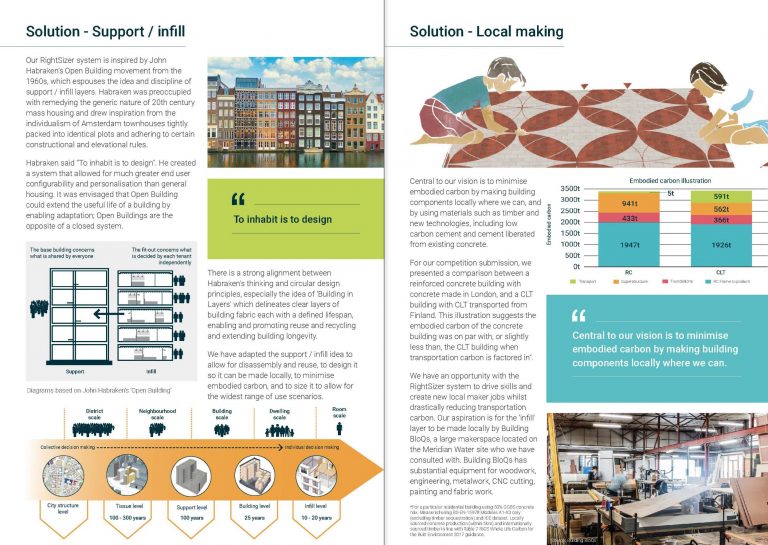
What’s the take-home for the industry as a whole?
Rory: As designers in the 2020s, we should be strongly advocating for resilience as a core design consideration, or our buildings risk becoming ‘stranded assets’. As an industry, we need a massive step change in ambition and technical know-how, not least in the context of ever-increasing ESG requirements, which will compel asset owners to incorporate resilience and adaptability as core valuation metrics.
Projects like RightSizer show its time to change how we do things, and we hope that this serves as a ‘how-to’ for architects, developers, and local authorities alike to build for 2030 and beyond. We are not proposing any obscure technologies, rather this is a new way of doing things with the same old materials. The future is coming at us fast, let’s not be afraid of it.
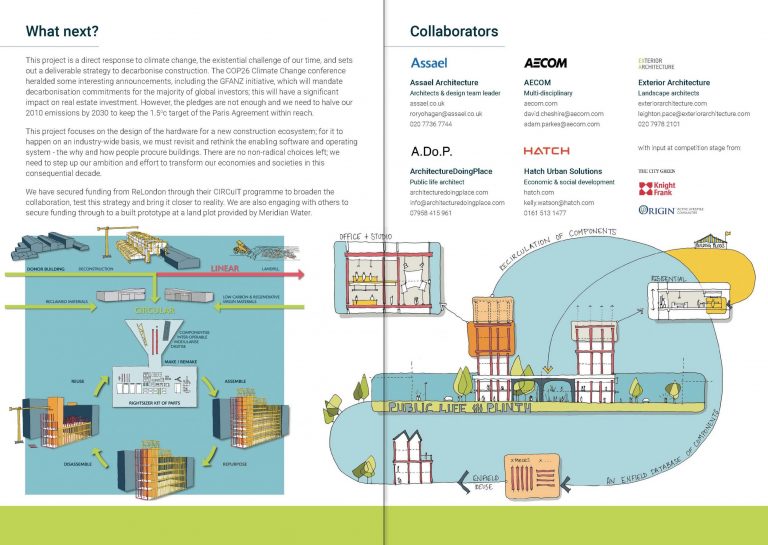
Download the whole report here, and get in touch with Rory O’Hagan if you’d like to discuss the concepts further.